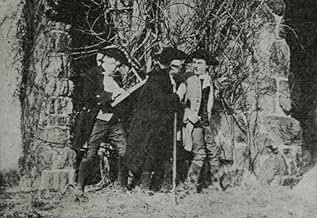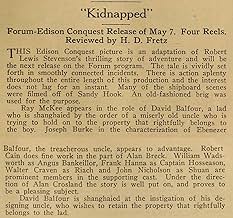Adicionar um enredo no seu idiomaIn Scotland in 1751, young David Balfour is shanghaied aboard a ship where he meets Jacobite rebel Alan Breck Stewart with whom he escapes to the Scottish Highlands, dodging the redcoats.In Scotland in 1751, young David Balfour is shanghaied aboard a ship where he meets Jacobite rebel Alan Breck Stewart with whom he escapes to the Scottish Highlands, dodging the redcoats.In Scotland in 1751, young David Balfour is shanghaied aboard a ship where he meets Jacobite rebel Alan Breck Stewart with whom he escapes to the Scottish Highlands, dodging the redcoats.
Franklyn Hanna
- Captain Hoseason
- (as Franklin Hanna)
Samuel N. Niblack
- Cluny McPherson
- (as Samuel Niblack)
Horace Haine
- Colin Campbell
- (as Horace Hain)
- Direção
- Roteiristas
- Elenco e equipe completos
- Produção, bilheteria e muito mais no IMDbPro
Enredo
Você sabia?
- CuriosidadesThrough 2013, this is the first in a string of twelve productions with the title of "Kidnapped" and which are also based on the classic Robert Louis Stevenson novel, after Kidnapped (1917), Kidnapped (1938), Kidnapped (1948), Kidnapped (TV Series) (1952), Kidnapped (1960), Kidnapped (TV Mini-Series) (1963), Kidnapped (1971), Kidnapped (TV Movie) (1973), Kidnapped (TV Mini-Series) (1978), Kidnapped (1986), Kidnapped (1995), and Kidnapped (TV Movie) (2005).
- Citações
Alan Breck: I'm vexed, sir. Ye've sunk my boat, and drowned my man. Be so kind as to land me at once!
Avaliação em destaque
Most adults today have seen at least one of a dozen Kidnapped movies as kids growing up. The Robert Louis Stevenson novel had captured the imagination of Hollywood producers from the budding years of cinema. The first film version of the Stevenson book was May 1917's "Kidnapped."
Edison Studios was barely kicking after its pioneering film days, dinged by an April 1917 United States Supreme Court ruling against Edison and his Motion Picture Patents Company (MPPC) trust's appeal of the SCOUS 1915 decision to put the kibosh to its monopoly. Once the breakup 1917 ruling happened, Edison Studios soon closed up its film production shop within a year and sold its assets to the Lincoln & Parker Film Company in Worcester, Massachusetts.
But before it did, however, Edison embarked on an ambitious series designed for children and families consisting of a short comedy, a travelogue, a news magazine clip, before the main attraction, a feature film was shown--all in an one evening's sitting. Edison Studios called this series the Conquest Production. "Kidnapped" was the ninth of twelve such packages of movies released.
This 1917 version of "Kidnapped" began the public's love affair with the Scottish Highlands. Despite being filmed in New York and New Jersey, "Kidnapped's" setting harkens back to the Jacobite days of the 1750's in Scotland. Director Alan Crosland, who later directed Al Jolson in what is considered the first talking picture, 1927's "The Jazz Singer," was able to use castle backdrops in the two states. It has been suggested Paterno Castle and Libbey Castle were the stone structures used for "Kidnapped."
Although the Stevenson book is a labyrinth of twists and turns of a complex history, the 1917 film is straightforward in its delivery, cutting out unnecessary sidebars and focusing in on young David Balfour after his parents died. His uncle, afraid he was getting kicked out of his castle which David inherited, set up his nephew's kidnapping and planned sale as a slave in North Caroline. When the character Alan Breck is introduced, viewers then get an education on the history of the intrigue and conspiracies occurring during the Jacobite Scottish period.
Edison's "Kidnapped" became the blueprint for the remakes of Stevenson's story, all of them with sound and dialogue. Making this 1917 film the only silent version ever produced.
Edison Studios was barely kicking after its pioneering film days, dinged by an April 1917 United States Supreme Court ruling against Edison and his Motion Picture Patents Company (MPPC) trust's appeal of the SCOUS 1915 decision to put the kibosh to its monopoly. Once the breakup 1917 ruling happened, Edison Studios soon closed up its film production shop within a year and sold its assets to the Lincoln & Parker Film Company in Worcester, Massachusetts.
But before it did, however, Edison embarked on an ambitious series designed for children and families consisting of a short comedy, a travelogue, a news magazine clip, before the main attraction, a feature film was shown--all in an one evening's sitting. Edison Studios called this series the Conquest Production. "Kidnapped" was the ninth of twelve such packages of movies released.
This 1917 version of "Kidnapped" began the public's love affair with the Scottish Highlands. Despite being filmed in New York and New Jersey, "Kidnapped's" setting harkens back to the Jacobite days of the 1750's in Scotland. Director Alan Crosland, who later directed Al Jolson in what is considered the first talking picture, 1927's "The Jazz Singer," was able to use castle backdrops in the two states. It has been suggested Paterno Castle and Libbey Castle were the stone structures used for "Kidnapped."
Although the Stevenson book is a labyrinth of twists and turns of a complex history, the 1917 film is straightforward in its delivery, cutting out unnecessary sidebars and focusing in on young David Balfour after his parents died. His uncle, afraid he was getting kicked out of his castle which David inherited, set up his nephew's kidnapping and planned sale as a slave in North Caroline. When the character Alan Breck is introduced, viewers then get an education on the history of the intrigue and conspiracies occurring during the Jacobite Scottish period.
Edison's "Kidnapped" became the blueprint for the remakes of Stevenson's story, all of them with sound and dialogue. Making this 1917 film the only silent version ever produced.
- springfieldrental
- 19 de jul. de 2021
- Link permanente
Principais escolhas
Faça login para avaliar e ver a lista de recomendações personalizadas
Detalhes
- Tempo de duração1 hora 4 minutos
- Cor
- Mixagem de som
- Proporção
- 1.33 : 1
Contribua para esta página
Sugerir uma alteração ou adicionar conteúdo ausente












